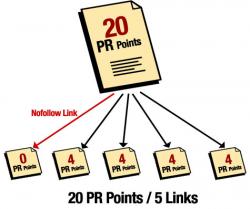
When a user types in a search query, the search engine’s number one goal is to return results that are high-quality, relevant, and able to best give them what they want. One of the 200+ factors Google takes into consideration to determine which web pages best fit the bill is PageRank.
What is PageRank?
PageRank is a link analysis algorithm used by Google to help determine the relative importance of a website.
Every website is given a PageRank score between 0 and 10 on an exponential scale. The handful of PageRank 10 domains, including USA.gov, Twitter.com and Adobe Reader Download, have the highest volume of inbound links of any sites on the web. The top sites set the bar, so to speak, and the 10-point scale plummets exponentially down from there. Google.com and Facebook.com are PR 9. PageRank 5 websites have a good number of inbound links, PR 3 and 4 sites have a fair amount, and brand new websites without any inbound links pointing to them start at PageRank 0.
Since Google wants to return page one results that are high quality, relevant, and trustworthy, it returns web pages with better PageRank scores higher up in the SERPs, all other things being equal.
Since PageRank is only one factor in the Google ranking algorithm, a high PageRank does not guarantee high rankings but it can significantly help.
What is “Link Juice” and What are PageRank “Points”?
When Site A links to your web page, Google sees this as Site A endorsing, or casting a vote for, your page. Google takes into consideration all of these link votes (i.e., the website’s link profile) to draw conclusions about the relevance and significance of individual web pages and your website as a whole. This is the basic concept behind PageRank.
When a website links to your site, or when you link internally from one of your pages to another, the link passes PageRank points. This passing of PageRank points is also commonly called “link juice” transfer.
The amount of link juice passed depends on two things: the number of PageRank points of the web page housing the link, and the total number of links on the web page that are passing PageRank. It’s worth noting here that while Google will give every website a public-facing PageRank score that is between 1 and 10, the “points” each page accumulates from the link juice passed by high-value inbound links can and do significantly surpass ten. For instance, web pages on the most powerful and significant websites can pass link juice points in the hundreds or thousands. To keep the rating system concise Google uses a lot of math (ask me in the comments if you want to hear about it) to correlate very large (and very small) PageRank values with a neat and clean 110 rating scale.
How Link Juice is Passed
Think of it this way: every web page has a limited amount of link juice it can pass, and the top of that limit is the total PageRank points that page has accrued. So, a web page with 20 accrued PageRank points cannot pass more than 20 points of link juice per page. If a page with 20 PageRank points links to one other page, that one link will transfer the full amount of link juice to that one other web page. But if a page with 20 PageRank points links to five web pages (internal or external), each link will only transfer one-fifth of the link juice. Google applies a decay value to every pass, so the actual numbers will be a little less than our diagram shows below. But to explain the PageRank concept simply, the formula is PR points divided by number of on-page links, or in this case, 20 divided by 5:
Visualize it: This diagram shows what it looks like when a web page with 20 PageRank points links out to 5 other web pages that, accordingly, each receive approximately 4 PageRank points.
What if you want to link to several resources to aid user experience, but you don’t want to dilute your link juice transfer? You can tell Google not to pass PageRank by amending some links with a rel=”nofollow” tag. So if you have a PageRank 18 web page that has 4 links on a page and three of those links have rel=”nofollow” tags, the one link that doesn’t have a rel=”nofollow” tag will get the full 18 points of link juice.
Transferring PageRank/Link Juice with Internal Linking
You can help Google see pages of your website as subject matter authorities by linking to your own important pages from related articles. For instance, if you have an article called How To Do Keyword Research, you can help reinforce to Google the relevance of this page for the subject/phrase “keyword research” by linking from an article reviewing a keyword research tool to your How To Do Keyword Research article. This linking strategy is part of effective siloing, which helps clarify your main website themes.
A Word of Caution: Now that you understand basically how PageRank works, we don’t want to give you the wrong idea. It’s not true that the more links you have, the better off you are. In today’s world, QUALITY is more important than quantity. Google penalties have caused many web owners to not only stop link building, but start link pruning instead. Poor quality links (i.e., links from spammy or off-topic sites) are like poison and can kill your search engine rankings. Only links from quality sites, and pages that are relevant to your website, will appear natural and not be subject to penalty. So never try to buy or solicit links earn them naturally or not at all.
Author: Chelsea Adams
Courtesy: www.bruceclay.com